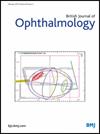阿达木单抗生物类似药治疗非感染性葡萄膜炎的疗效与原药阿达木单抗相似。
IF 3.5
2区 医学
Q1 OPHTHALMOLOGY
引用次数: 0
摘要
目的比较阿达木单抗生物仿制药和阿达木单抗作为非感染性葡萄膜炎(NIU)患者初始生物治疗在实现和维持炎症控制方面的疗效。方法本研究为多中心回顾性队列研究。开始阿达木单抗治疗后,每只眼睛记录了葡萄膜炎复发事件。复发定义为临床诊断为眼内炎症,需要增加或改变局部或全身免疫抑制。复发率和12个月后首次复发的时间比较用阿达木单抗或生物仿制药治疗的眼睛。结果148例诊断为NIU的患者中260只眼接受了原药阿达木单抗(n=193, 74.23%)或生物仿制药(n=67, 25.77%)治疗。未复发患者从基线开始的中位随访时间为24.0个月(IQR为18.0,24.0)。97只眼睛出现葡萄膜炎复发(37.31%,阿达木单抗组76只,生物仿制药组21只)。到12个月时,阿达木单抗组的估计复发率为24.2%,而生物仿制药组为28.3%(相对风险=1.17,95% CI 0.58至1.77)。起始阿达木单抗组12个月随访时的平均复发时间为4.91个月,而生物仿制药组为5.04个月(平均差0.13个月,95% CI -1.33至1.54个月)。结论:我们的研究表明,使用12个月后,阿达木单抗生物仿制药在预防难治性NIU患者疾病复发方面并不逊于原药阿达木单抗。这些结果支持使用阿达木单抗生物仿制药治疗NIU。本文章由计算机程序翻译,如有差异,请以英文原文为准。
Adalimumab biosimilars have similar efficacy to originator adalimumab when treating non-infectious uveitis.
AIMS
To compare the efficacy in achieving and maintaining control of inflammation between adalimumab biosimilars and originator adalimumab as initial biologic treatment among patients with non-infectious uveitis (NIU).
METHODS
This is a multicentre retrospective cohort study. Events of uveitis relapse were noted per eye following initiation of adalimumab treatment. Relapses were defined as the clinical diagnosis of intraocular inflammation, requiring an increase or change in local or systemic immunosuppression. Relapse rates and time to first relapse by 12 months were compared between eyes treated with originator adalimumab or a biosimilar.
RESULTS
260 eyes of 148 patients diagnosed with NIU were treated with either originator adalimumab (n=193, 74.23%) or a biosimilar (n=67, 25.77%). Median follow-up from baseline for patients who did not relapse was 24.0 months (IQR 18.0, 24.0). Uveitis relapses occurred in 97 eyes (37.31%, 76 in the originator adalimumab group and 21 in the biosimilar group). By 12 months, the estimated relapse rate was 24.2% in the originator adalimumab group versus 28.3% in the biosimilar group (relative risk=1.17, 95% CI 0.58 to 1.77). The average time to relapse by 12 months follow-up for the originator adalimumab group was 4.91 months compared with 5.04 months in the biosimilar group (mean difference 0.13 months, 95% CI -1.33 to 1.54 months).
CONCLUSION
Our study suggests that by 12 months of use, biosimilar adalimumab agents were not inferior to originator adalimumab in preventing disease relapse among patients with refractory NIU. These results support the use of biosimilar adalimumab for treating NIU.
求助全文
通过发布文献求助,成功后即可免费获取论文全文。
去求助
来源期刊
CiteScore
10.30
自引率
2.40%
发文量
213
审稿时长
3-6 weeks
期刊介绍:
The British Journal of Ophthalmology (BJO) is an international peer-reviewed journal for ophthalmologists and visual science specialists. BJO publishes clinical investigations, clinical observations, and clinically relevant laboratory investigations related to ophthalmology. It also provides major reviews and also publishes manuscripts covering regional issues in a global context.

 求助内容:
求助内容: 应助结果提醒方式:
应助结果提醒方式:


